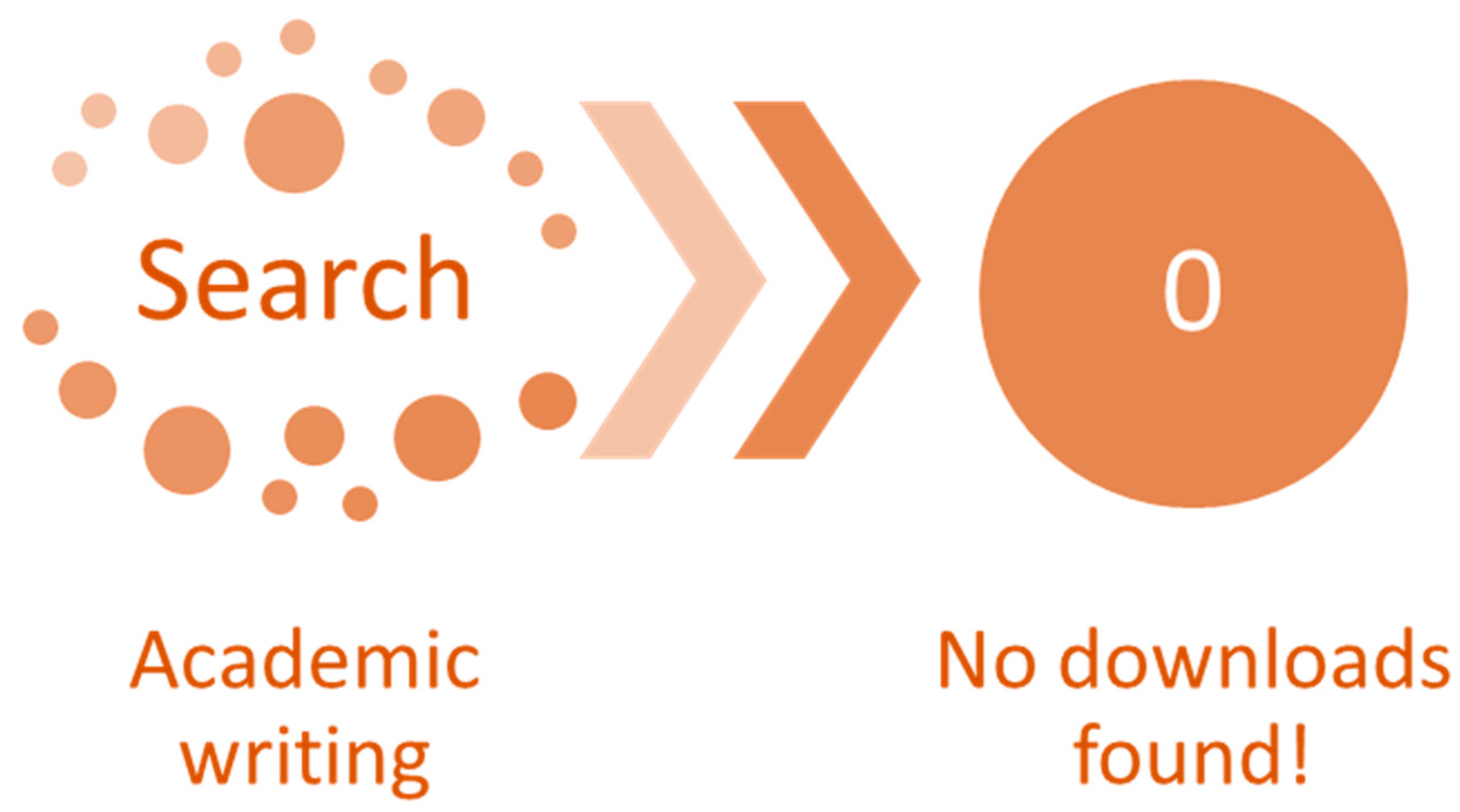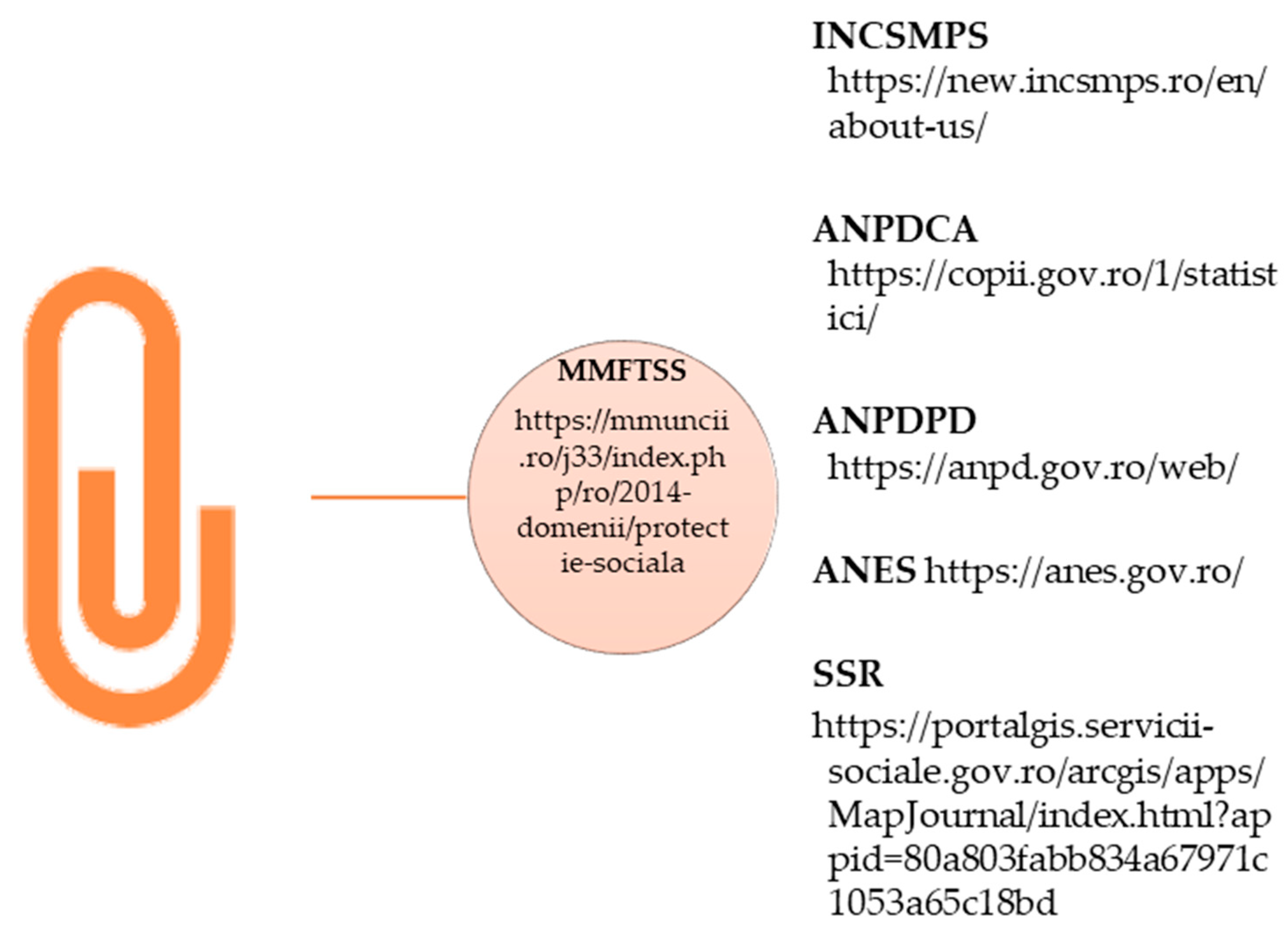Socio-Educational Resources for Academic Writing—Open-Access, Digital Data for Social Work Programs in Romanian Universities
Abstract
1. Introduction
2. Methodology
3. Results
3.1. Academic Writing in Social Work University Programs—Social Protection Research, Innovation, and Digital Inclusion in National Programs
3.2. Open-Access Academic Resources for Writing in SWHE
3.3. Open-Access Non-Academic Resources for Writing in SWHE
- A.
- reports (1—if it is available, 0—not available)
- B.
- research or publications (1—if it is available, 0—not available)
- C.
- laws (1- if it is available, 0—not available)
- D.
- good practice example (1—if it is available, 0—not available)
- E.
- data statistics (1—if it is available, 0—not available)
- F.
- human resources information (1—if it is available, 0—not available)
- G.
- partnerships (1—if it is available, 0—not available)
4. Discussion
5. Conclusions and Practical Recommendations
Funding
Institutional Review Board Statement
Informed Consent Statement
Data Availability Statement
Acknowledgments
Conflicts of Interest
References
- Berei, E. For the Sake of the Cause—Persistence of Romanian Higher Education Students in Finishing their Studies. Cent. Eur. J. Educ. Res. 2019, 1, 22–30. [Google Scholar] [CrossRef]
- Kim, I.; Kuljis, J. Applying content analysis to web-based content. J. Comput. Inf. Technol. 2010, 18, 369–375. [Google Scholar] [CrossRef]
- Hughes, N.; Wainwright, S.; Ward, N. Developing the Writing Skills of Social Work Students: Connecting Academic and Professional Expertise. J. Acad. Writ. 2011, 1, 54–60. [Google Scholar] [CrossRef]
- Lindsay, J.B. A practical guide to academic writing and publishing. Eur. Bus. Rev. 2018, 18, 479–490. [Google Scholar]
- Bailey, S. Academic Writing: A Handbook for International Students; Routledge: London, UK, 2014. [Google Scholar]
- Mewburn, I.; Firth, K.; Lehmann, S. How to Fix Academic Writing Trouble: A Practical Guide; McGraw-Hill Education: Singapore, 2018. [Google Scholar]
- Hutton, L.; Gibson, G. “Kinds of Writing”: Student Conceptions of Academic and Creative Forms of Writing Development. In Developing Writers in Higher Education: A Longitudinal Study; Gere, A.R., Ed.; University of Michigan Press: Ann Arbor, MI, USA, 2019; pp. 89–112. Available online: http://www.jstor.org/stable/j.ctvdjrpt3.9 (accessed on 7 March 2025).
- Jones-Mensah, I.; Hilton, K. Assessing the statistical differences in academic writing skills across disciplines in higher education. Cogent Educ. 2024, 11, 1. [Google Scholar] [CrossRef]
- Stephens, P.A.; Campbell, J.M. Scientific writing and editing: A new role for the library. Bull. Med. Libr. Assoc. 1995, 83, 478–482. [Google Scholar] [PubMed] [PubMed Central]
- Thomas, C.G. Research Methodology and Scientific Writing; Springer: Thrissur, India, 2021. [Google Scholar]
- Prain, V.; Hand, B. Coming to Know More Through and From Writing. Educ. Res. 2016, 45, 430–434. [Google Scholar] [CrossRef]
- Jusslin, S.; Widlund, A. Academic writing workshopping to support students with bachelor’s or master’s theses: A more-than-human approach. Teach. High. Educ. 2021, 29, 233–250. [Google Scholar] [CrossRef]
- Schcolnik, M. Digital Tools in Academic Writing? J. Acad. Writ. 2018, 8, 121–130. [Google Scholar] [CrossRef]
- Rai, L.; Ferguson, G.; Giddings, L. Writing as Social Work: Thematic Review of the Literature. Br. J. Soc. Work 2025, 55, 25–44. [Google Scholar] [CrossRef]
- Rădulescu, A. Dezvoltarea Profesiei și Rolul Asistentului Social în România—The Development of the Profession and the Role of the Social Worker in Romania; Muntean, A., Sagebiel, J., Eds.; Practici în Asistența Socială: România și Germania—Practices in Social Work: Romania and Germany; Editura Polirom: Iași, România, 2007; pp. 161–170. ISBN 978-973-46-0544-6. [Google Scholar]
- Rostás, Z. Monografia ca Utopie. Interviuri cu Henri H. Stahl (1985–1987)—Monograph as Utopia. Interviews with Henri H. Stahl (1985–1987); Editura Paideia: Bucuresti, Romania, 2000. [Google Scholar]
- Buzducea, D. Sisteme Moderne de Asistenţă Socială. Tendinţe Globale şi Practici Locale—Modern Social Assistance Systems. Global Trends and Local Practices; Polirom: Iași, România, 2009; ISBN 978-973-46-1332-8. [Google Scholar]
- CNASR. Colegiul National al Asistențiolor Sociali din România—National College of Social Workers of Romania. Available online: https://www.cnasr.ro/ (accessed on 7 March 2025).
- MEC. Ministerul Educației și Cercetării—Ministry of Education and Research. Available online: https://www.edu.ro/institutii-invatamant-superior (accessed on 7 March 2025).
- ARACIS. Agenția Română de Asigurare a Calității în Învățământul Superior—Romanian Agency for Quality Assurance in Higher Education. Standarde Specifice Privind Evaluarea Externă a Calității Academice a Programelor de Studii din Domeniile de Licență și Mastera Aferente Comisiei de Specialitate nr. 4 Științe Sociale, Politice și Ale Comunicării. 2023. Available online: https://www.aracis.ro/standarde-specifice-evaluare-licenta/ (accessed on 7 March 2025).
- Universitatea de Vest din Timisoara—Vest University from Timisoara. Available online: https://www.uvt.ro/ (accessed on 7 March 2025).
- Universitatea Lucian Blaga din Sibiu—Lucian Blaga University from Sibiu—ULBS. Available online: https://www.ulbsibiu.ro/ro/ (accessed on 7 March 2025).
- Universitatea Babes—Bolyai din Cluj—Babes—Bolyai University from Cluj. Available online: https://www.ubbcluj.ro/ro/ (accessed on 7 March 2025).
- MCID. Ministerul Cercetării, Inovării și Digitalizării—The Authority for Digitization of Romania. Available online: https://www.mcid.gov.ro/sistemul-de-cercetare/descriere/ (accessed on 7 March 2025).
- Revista de Asistenta Sociala—Social Work Review. Available online: http://www.swreview.ro/index.pl/home_en (accessed on 7 March 2025).
- Biblioteca Virtuala de Sociologie—Virtual Library of Sociology. Available online: https://bibliotecadesociologie.ro/ (accessed on 7 March 2025).
- Revista de Cercetare si Interventie Sociala—Journal of Research and Social Intervention. Available online: https://www.rcis.ro/ (accessed on 7 March 2025).
- MMFTSS. Ministerul Muncii, Familiei, Tineretului și Solidarității Sociale—Ministry of Labour, Family, Youth and Social Solidarity. Available online: https://mmuncii.ro/j33/index.php/ro/2014-domenii/protectie-sociala (accessed on 7 March 2025).
- KINCS. European Family Policy Ranking. 2019. Available online: https://www.koppmariaintezet.hu/en/283-kincs-european-family-policy-ranking-2019 (accessed on 7 March 2025).
- INCSMPS. Institutului Național de Cercetare în Domeniul Muncii și Protecției Sociale—National Institute for Scientific Research in the Field of Labour and Social Protection. Available online: https://new.incsmps.ro/en/about-us/ (accessed on 7 March 2025).
- ANPDCA. Autoritatea Naționale Pentru Protecția Drepturilor Copilului și Adopție—National Authority for the Protection of Children’s Rights and Adoption. Available online: https://copii.gov.ro/1/statistici/ (accessed on 7 March 2025).
- ANPDPD. Autoritatea Nationala de Protectie al Derepturilor Persoanlor cu Disabilitate—National Authority for the Protection of the Rights of Persons with Disabilities. Available online: https://anpd.gov.ro/web/ (accessed on 7 March 2025).
- ANES. Agenția Națională Pentru Egalitate de Șanse între Femei și Bărbați—National Agency for Equal Opportunities Between Women and Men. Available online: https://anes.gov.ro/ (accessed on 7 March 2025).
- SSR. Servicii SocialeServicii Sociale în România—Social Services in Romania. Available online: https://portalgis.servicii-sociale.gov.ro/arcgis/apps/MapJournal/index.html?appid=80a803fabb834a67971c1053a65c18bd (accessed on 7 March 2025).
- ANOFM. Agenția Națională de Ocupare a Forței de Muncă—National Employment Agency. Available online: https://www.anofm.ro/# (accessed on 7 March 2025).
- PCU. Punctul de Contact Unic Electronic—Single Point of Contact. Available online: https://edirect.e-guvernare.ro/SitePages/landingpage.aspx (accessed on 7 March 2025).
- EURES. European Employment Services. Available online: https://eures.europa.eu/eures-services_ro (accessed on 7 March 2025).
- AJOFM. Agentia Judeteana de Ocupare a Fortei de Munca—County Employment Agencies. Available online: https://www.anofm.ro/agentii-judetene/ (accessed on 7 March 2025).
- Google. Available online: https://www.google.com/ (accessed on 7 March 2025).
- DGASPC. Directia Generala de Asistenta Sociala si Protectia Copilului—General Directorate of Social Assistance and Child Protection. Available online: https://copii.gov.ro/1/harta-contacte-dgaspc-uri/ (accessed on 7 March 2025).



| Keyword Name | Frequency (N) |
|---|---|
| Academic writing | 0 |
| Evidence-based (SW, intervention programs, practice) | 7 |
| Digital (resources, literacy, digitalization, agility index, era, age, environment, inequality, divide) | 10 |
| Keyword Name | Frequency (N) |
|---|---|
| Academic writing | 0 |
| Evidence-based (EU FAR Database) | 2 |
| Digital | 2 |
| Keyword Name | Frequency (N) |
|---|---|
| Academic writing | 2 |
| Evidence-based | 25 |
| Digital | 33 |
| Vulnerable Groups | Measurement |
|---|---|
| Children | 5 |
| People with disabilities | 5 |
| Elderly | 5 |
| The Romanian Names and the categories of OA and Digital Resources |
|---|
| Academic Document Sites |
| Agenția Română de Asigurare a Calității în Învățământul Superior (ARACIS) |
| Universitatea de “Vest” din Timișoara (UVT) |
| Universitatea “Lucian Blaga” din Sibiu (ULBS) |
| Universitatea “Babeș—Bolyai” din Cluj (UBBC) |
| Academic and Research Innovation Sites |
| Ministerul Cercetării, Inovării și Digitalizării (MCID) |
| Revista de Asistență Socială |
| Biblioteca Virtuală de Sociologie |
| Revista de Cercetare și Intervenție Socială |
| Non-Academic and Social Protection Functionality Site |
| Ministerul Muncii, Familiei, Tineretului și Solidarității Sociale (MMFTSS) |
Disclaimer/Publisher’s Note: The statements, opinions and data contained in all publications are solely those of the individual author(s) and contributor(s) and not of MDPI and/or the editor(s). MDPI and/or the editor(s) disclaim responsibility for any injury to people or property resulting from any ideas, methods, instructions or products referred to in the content. |
© 2025 by the author. Licensee MDPI, Basel, Switzerland. This article is an open access article distributed under the terms and conditions of the Creative Commons Attribution (CC BY) license (https://creativecommons.org/licenses/by/4.0/).
Share and Cite
Berei, E.B. Socio-Educational Resources for Academic Writing—Open-Access, Digital Data for Social Work Programs in Romanian Universities. Trends High. Educ. 2025, 4, 38. https://doi.org/10.3390/higheredu4030038
Berei EB. Socio-Educational Resources for Academic Writing—Open-Access, Digital Data for Social Work Programs in Romanian Universities. Trends in Higher Education. 2025; 4(3):38. https://doi.org/10.3390/higheredu4030038
Chicago/Turabian StyleBerei, Emese Beáta. 2025. "Socio-Educational Resources for Academic Writing—Open-Access, Digital Data for Social Work Programs in Romanian Universities" Trends in Higher Education 4, no. 3: 38. https://doi.org/10.3390/higheredu4030038
APA StyleBerei, E. B. (2025). Socio-Educational Resources for Academic Writing—Open-Access, Digital Data for Social Work Programs in Romanian Universities. Trends in Higher Education, 4(3), 38. https://doi.org/10.3390/higheredu4030038







